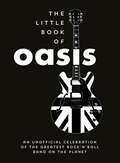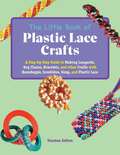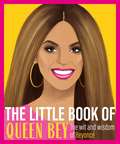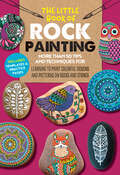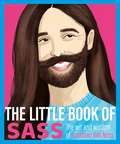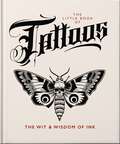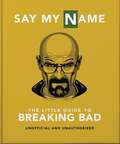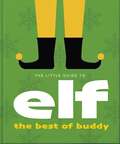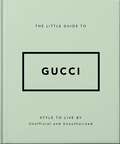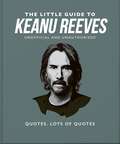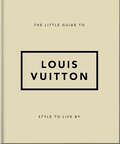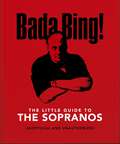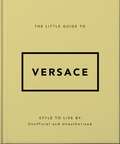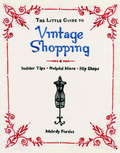- Table View
- List View
The Little Book of Natural Cleaning (Home Sweet Home)
by The Little Book of Natural CleaningHome is where the heart is... Home is the place where everyone should feel happy and at peace . . . and that means a house that is clean, safe and welcoming to all.Using traditional, natural cleaning methods to tackle everyday chores is not only a simple and effective way to help the environment, but also helps safeguard your family, friends and pets from germs and the potentially harmful side-effects of many modern cleaning products.THE LITTLE BOOK OF NATURAL CLEANING contains everything you need to know about cleaning with easy-to-find and inexpensive natural ingredients like lemons, bicarbonate of soda and white vinegar. Your home will soon be fresh, clean and safe for all the family.And whilst you #StayHome, don't miss these other great titles from Sphere Books: ** Distract Yourself: 101 Positive Things to Do and Learn Whilst You Stay Home ** ** The Bumper Book of Would You Rather? Over 350 hilarious hypothetical questions for ages 6 to 106 **** AA British Road Map Puzzle Book: Addictive map-based brain-games for anyone in lockdown ** ** Shelf Respect: A Book Lovers' Guide to Curating Book Shelves at Home **
The Little Book of Oasis: An Unofficial Celebration of the Greatest Rock 'n' Roll Band on the Planet
by Summersdale PublishersWhether it's Liam's swagger, Noel's carefully crafted songwriting or the collective Northern soul at the heart of their anthems - Oasis are simply unforgettable. With candid quotes, upfront facts and a shedload of tidy trivia, this book covers the supersonic highs and catastrophic lows of the maddest, baddest rock'n'roll band on the planet.
The Little Book of Oasis: An Unofficial Celebration of the Greatest Rock 'n' Roll Band on the Planet
by Summersdale PublishersWhether it's Liam's swagger, Noel's carefully crafted songwriting or the collective Northern soul at the heart of their anthems - Oasis are simply unforgettable. With candid quotes, upfront facts and a shedload of tidy trivia, this book covers the supersonic highs and catastrophic lows of the maddest, baddest rock'n'roll band on the planet.
The Little Book of Plastic Lace Crafts: A Step-by-Step Guide to Making Lanyards, Key Chains, Bracelets, and other Crafts with Boondoggle, Scoubidou, Gimp, and Plastic Lace
by Yonatan SetbonSpice up your summer with this handy DIY guide packed with easy projects, beginners' tutorials, camp crafts, and more!Break has come and school is out. Keeping your kids entertained at home without screens may seem difficult, but it doesn&’t have to be. Why not make your break a &“DIY summer&” with The Little Book of Plastic Lace Crafts? This step-by-step guide to creating lanyards, key chains, bracelets, and other crafts with plastic lace features full-color diagrams and easy-to-follow text. It can be used at any proficiency level, starting off with basic stitching techniques before moving on to more advanced methods in order to teach you how to: Create a standard lanyard Integrate practical and creative techniques Incorporate new and playful ideas And more! Written and illustrated by a highly experienced lanyard artist, The Little Book of Plastic Lace Crafts is the screen-free summertime entertainment that the whole family can enjoy!
The Little Book of Queen Bey: The Wit and Wisdom of Beyoncé
by Various'I will always believe in the strength we have as women.' As the queen of pop music since the glory days of Destiny's Child to her incredible solo career, Beyoncé is one of the most inspiring and powerful women in music. The Little Book of Queen Bey is a collection of the most iconic quotes from a woman who needs no introduction. When it comes to self-love, empowerment and sisterhood, Beyoncé has more wisdom than anybody. From how to be an independent woman to positive affirmations that will give you hope, The Little Book of Queen Bey is the perfect gift for fans of the goddess of pop. Prepare to be inspired.
The Little Book of Queen Bey: The Wit and Wisdom of Beyoncé
by Various'I will always believe in the strength we have as women.' As the queen of pop music since the glory days of Destiny's Child to her incredible solo career, Beyoncé is one of the most inspiring and powerful women in music. The Little Book of Queen Bey is a collection of the most iconic quotes from a woman who needs no introduction. When it comes to self-love, empowerment and sisterhood, Beyoncé has more wisdom than anybody. From how to be an independent woman to positive affirmations that will give you hope, The Little Book of Queen Bey is the perfect gift for fans of the goddess of pop. Prepare to be inspired.
The Little Book of Rock Painting: More Than 50 Tips and Techniques for Learning to Paint Colorful Designs and Patterns on Rocks and Stones
by Diana Fisher F. Sehnaz Bac Margaret Vance Marisa RedondoCreative exercises, prompts, and step-by-step projects for turning nature into three-dimensional art!The Little Book of Rock Painting teaches beginners the fundamentals of the medium in an engaging and fun way. Aspiring artists will discover how to gather and prepare their rocks to create three-dimensional masterpieces that are truly one with nature. Written and illustrated by three talented rock-painting artists, the book features a range of contemporary designs to experiment with, from patterns and animals to mandalas and dots. The instructions are easy to follow and invite creativity and originality. Also included are simple ways to create exciting special effects.Grab your colors, head outside—and start painting beautiful works of art on stones!
The Little Book of Sass: The Wit and Wisdom of Jonathan Van Ness
by Various'You're strong, you're a Kelly Clarkson song, you got this.'Everything that comes out of Jonathan Van Ness's mouth is a gift from god. He's the man who taught us about hair, self-care and CON-FI-DONCE. The Little Book of Sass is a collection of the most iconic quotes from the sassiest man around on love, men, self-care and friendship.From the power of the heel to how to be the most supportive friend, The Little Book of Sass is the most shamazing gift for any JVN fans in your life.
The Little Book of Sass: The Wit and Wisdom of Jonathan Van Ness
by Various'You're strong, you're a Kelly Clarkson song, you got this.'Everything that comes out of Jonathan Van Ness's mouth is a gift from god. He's the man who taught us about hair, self-care and CON-FI-DONCE. The Little Book of Sass is a collection of the most iconic quotes from the sassiest man around on love, men, self-care and friendship.From the power of the heel to how to be the most supportive friend, The Little Book of Sass is the most shamazing gift for any JVN fans in your life.
The Little Book of Tattoos (The\little Book Of... Ser.)
by Orange Hippo!Think you know ink? Think again!Whether your tattoo is to honour a loved one, to remember an event, to state your beliefs or simply to look good, there's always more to getting a tattoo than meets the eye. For example, do you know that having a tat links you to a deep and multicultural tradition stretching back thousands of years? Yes, even that one you got as a drunken dare . . .From Siberia to Polynesia, tattoos have always been part of human history. Vilified and revered, shunned and celebrated, the history of the tattoo is as colourful and detailed as a master's design. The Little Guide to Tattoos is packed with fascinating history, fun facts, quirky quotes and deep dives onto some of the most iconic symbols.Whether you're a full-on aficionado or cautiously ink-curious, The Little Guide to Tattoos is the only guide you need to all things tattoo. "Show me a man with a tattoo and I'll show you a man with an interesting past." - Jack London"Tattoos are like stories - they're symbolic of the important moments in your life." - Pamela Anderson
The Little Book of Tattoos (The\little Book Of... Ser.)
by Orange Hippo!Think you know ink? Think again!Whether your tattoo is to honour a loved one, to remember an event, to state your beliefs or simply to look good, there's always more to getting a tattoo than meets the eye. For example, do you know that having a tat links you to a deep and multicultural tradition stretching back thousands of years? Yes, even that one you got as a drunken dare . . .From Siberia to Polynesia, tattoos have always been part of human history. Vilified and revered, shunned and celebrated, the history of the tattoo is as colourful and detailed as a master's design. The Little Guide to Tattoos is packed with fascinating history, fun facts, quirky quotes and deep dives onto some of the most iconic symbols.Whether you're a full-on aficionado or cautiously ink-curious, The Little Guide to Tattoos is the only guide you need to all things tattoo. "Show me a man with a tattoo and I'll show you a man with an interesting past." - Jack London"Tattoos are like stories - they're symbolic of the important moments in your life." - Pamela Anderson
The Little Guide to Breaking Bad: The Most Addictive TV Show Ever Made (The\little Book Of... Ser.)
by Orange Hippo!"I am not in danger, Skyler. I am the danger!"When a mild-mannered chemistry teacher teamed up with a small-time meth dealer - and, over five chaotic and addictive seasons, transforms into a ruthless kingpin - nobody expected the show to become a global sensation. But the gripping tale of Walt's descent into the criminal underworld has smashed records, making Breaking Bad the most critically acclaimed show of all time.Now the legacy of this trailblazing series has been refined into the gift that keeps on giving. Say My Name: The Little Guide to Breaking Bad is contaminated with the loco misadventures of Walt, Jesse, Skyler, Saul, Gus, Mike and Hank through a wealth of wicked wit and wisdom, and classic, killer catchphrases. Just remember, tread lightly - we wouldn't want you to get hooked on the show all over again. Or would we?
The Little Guide to Breaking Bad: The Most Addictive TV Show Ever Made (The\little Book Of... Ser.)
by Orange Hippo!"I am not in danger, Skyler. I am the danger!"When a mild-mannered chemistry teacher teamed up with a small-time meth dealer - and, over five chaotic and addictive seasons, transforms into a ruthless kingpin - nobody expected the show to become a global sensation. But the gripping tale of Walt's descent into the criminal underworld has smashed records, making Breaking Bad the most critically acclaimed show of all time.Now the legacy of this trailblazing series has been refined into the gift that keeps on giving. Say My Name: The Little Guide to Breaking Bad is contaminated with the loco misadventures of Walt, Jesse, Skyler, Saul, Gus, Mike and Hank through a wealth of wicked wit and wisdom, and classic, killer catchphrases. Just remember, tread lightly - we wouldn't want you to get hooked on the show all over again. Or would we?
The Little Guide to Elf
by Orange Hippo!A modern Christmas classic, Elf burst onto cinema screens over 20 years ago and has been charming people ever since. In 2003, Buddy the Elf went on a journey to find his father, and ultimately help Santa save Christmas, and since then the world has gone Elf mad. There are only a few modern Christmas films that everyone agrees are instant classics, but Elf is definitely one. A wholesome and deeply funny film, it captures everything important about Christmas: family, acceptance, fun and - most importantly - Santa. Regularly cited as one of the best Christmas films of all time, for many people, Christmas hasn't started until they've watched Elf.Stuffed with more classic quotes, quips and wisecracks from Buddy, his human family and North Pole colleagues, as well as a cast of cynical New Yorkers whom Buddy befriends and with more treats than you'll find under the Christmas tree, the Little Book of Elf is the perfect gift for the Elf-mad member of your family, which, last time we looked, was everyone!"I just like to smile. Smiling's my favorite." Buddy."Why don't you just say it? I'm the worst toy maker in the world. I'm a cotton-headed ninny-muggins."Buddy, to Ming Ming."Then I traveled through the seven levels of the Candy Cane forest, past the sea of twirly-swirly gum drops, and then I walked through the Lincoln Tunnel."Buddy.44 per centThe percentage of British people* who re-watch Elf every single year, according to OnBuy study, 2020.* Britons will spend around 14 days of their lifetime re-watching Elf.
The Little Guide to Elf
by Orange Hippo!A modern Christmas classic, Elf burst onto cinema screens over 20 years ago and has been charming people ever since. In 2003, Buddy the Elf went on a journey to find his father, and ultimately help Santa save Christmas, and since then the world has gone Elf mad. There are only a few modern Christmas films that everyone agrees are instant classics, but Elf is definitely one. A wholesome and deeply funny film, it captures everything important about Christmas: family, acceptance, fun and - most importantly - Santa. Regularly cited as one of the best Christmas films of all time, for many people, Christmas hasn't started until they've watched Elf.Stuffed with more classic quotes, quips and wisecracks from Buddy, his human family and North Pole colleagues, as well as a cast of cynical New Yorkers whom Buddy befriends and with more treats than you'll find under the Christmas tree, the Little Book of Elf is the perfect gift for the Elf-mad member of your family, which, last time we looked, was everyone!"I just like to smile. Smiling's my favorite." Buddy."Why don't you just say it? I'm the worst toy maker in the world. I'm a cotton-headed ninny-muggins."Buddy, to Ming Ming."Then I traveled through the seven levels of the Candy Cane forest, past the sea of twirly-swirly gum drops, and then I walked through the Lincoln Tunnel."Buddy.44 per centThe percentage of British people* who re-watch Elf every single year, according to OnBuy study, 2020.* Britons will spend around 14 days of their lifetime re-watching Elf.
The Little Guide to Gucci: Style to Live By (The\little Book Of... Ser.)
by Orange Hippo!Since 1921, Gucci has been a titan of the luxury fashion industry. Celebrated for its exclusive high-end accessories, the brand reigns supreme for its signature leather goods and decadent garments that have elegantly combined the understated with the opulent.More than 100 years ago, Gucci took the world by storm as a luxury luggage and equstrian outfitter, quickly becoming a giant of 1990s haute couture. The highly sought-after products would only become more exclusive with time, and since then the company has gone from strength to strength. Under the watchful eyes of Alessandro Michele and now, Sabato de Sarno, the brand has made its mark on streetwear, inspring a new generation of fans.Brimming with fascinating facts and inspirational quotes from celebrities, fans and the creative heads at Gucci, this little guide documents not only the brand's extraordinary journey, but also the elusive family at the helm.'Quality is remembered long after price is forgotten.' Aldo Gucci
The Little Guide to Gucci: Style to Live By (The\little Book Of... Ser.)
by Orange Hippo!Since 1921, Gucci has been a titan of the luxury fashion industry. Celebrated for its exclusive high-end accessories, the brand reigns supreme for its signature leather goods and decadent garments that have elegantly combined the understated with the opulent.More than 100 years ago, Gucci took the world by storm as a luxury luggage and equstrian outfitter, quickly becoming a giant of 1990s haute couture. The highly sought-after products would only become more exclusive with time, and since then the company has gone from strength to strength. Under the watchful eyes of Alessandro Michele and now, Sabato de Sarno, the brand has made its mark on streetwear, inspring a new generation of fans.Brimming with fascinating facts and inspirational quotes from celebrities, fans and the creative heads at Gucci, this little guide documents not only the brand's extraordinary journey, but also the elusive family at the helm.'Quality is remembered long after price is forgotten.' Aldo Gucci
The Little Guide to Keanu Reeves: The Nicest Guy in Hollywood (The\little Book Of... Ser.)
by Orange Hippo!Why we're all crazy about Keanu.When even your name is beautiful (Keanu means "cool breeze over the mountains"), it's no surprise that Keanu Reeves was destined to become one of world's biggest and most enduring film stars. Bursting onto our screens in eighties in River's Edge and Bill and Ted's Excellent Adventure, his run of smash hits continued through the next decade with Point Break, Much Ado About Nothing, Speed, and his groundbreaking role as Neo in The Matrix. Then, in 2014, his sensational comeback in the John Wick films catapulted him right back to the top of the Hollywood A-list.No stranger to tragedy in his personal life - his baby was stillborn and his partner died in a car accident two years later - Keanu is as famous for his kindness, wisdom and philanthropy as he is for his film career. He has secretly donated large sums to children's hospitals, given generous gifts to crew members on set and made headlines for his kindness to fans. Join us in a celebration of the man widely known as "the Internet's boyfriend"."If you can make a woman laugh, you're seeing the most beautiful thing on God's earth." Keanu Reeves on womenBorn in Lebanon and raised in Australia, the USA and Canada, Reeves is of Chinese, English, Irish, Hawaiian and Portuguese descent. (But he's Canadian, OK?)
The Little Guide to Louis Vuitton: Style to Live By (The\little Book Of... Ser.)
by Orange Hippo!For over 150 years, Louis Vuitton's monographed bags have been associated with style and luxury. Born in 1821, he had left home at 13 to seek his fortune in Paris where he became an apprentice box-maker which eventually led him to introductions at the French Royal Court. With royal endorsement, Louis opened of his first workshop in 1854 where his skills and innovations established his brand as one of Europe's most popular.Passing his passion for crafting beautiful luggage onto his son, Georges, and later his grandson Gaston-Louis, they ensured the company continued to grow, surviving two world wars, to become the luxury brand it's renowned for.Louis Vuitton stores opened in cities throughout the world and expanded into other high-end brands. The merger in 1987 with Möet Hennessy created the megabrand LVMH, and in 1997 the appointment of Marc Jacobs launched Louis Vuitton into the world of fashion."The Louis Vuitton woman is more about a quality - a quality within some women that needs to come forward, to be noticed and recognised." Marc Jacobs"There's a lot of baggage that comes along with our family, but it's like Louis Vuitton baggage." Kim Kardashian"Luxury must be comfortable, otherwise it is not luxury." Louis Vuitton
The Little Guide to Louis Vuitton: Style to Live By (The\little Book Of... Ser.)
by Orange Hippo!For over 150 years, Louis Vuitton's monographed bags have been associated with style and luxury. Born in 1821, he had left home at 13 to seek his fortune in Paris where he became an apprentice box-maker which eventually led him to introductions at the French Royal Court. With royal endorsement, Louis opened of his first workshop in 1854 where his skills and innovations established his brand as one of Europe's most popular.Passing his passion for crafting beautiful luggage onto his son, Georges, and later his grandson Gaston-Louis, they ensured the company continued to grow, surviving two world wars, to become the luxury brand it's renowned for.Louis Vuitton stores opened in cities throughout the world and expanded into other high-end brands. The merger in 1987 with Möet Hennessy created the megabrand LVMH, and in 1997 the appointment of Marc Jacobs launched Louis Vuitton into the world of fashion."The Louis Vuitton woman is more about a quality - a quality within some women that needs to come forward, to be noticed and recognised." Marc Jacobs"There's a lot of baggage that comes along with our family, but it's like Louis Vuitton baggage." Kim Kardashian"Luxury must be comfortable, otherwise it is not luxury." Louis Vuitton
The Little Guide to The Sopranos: The only ones you can depend on (The\little Book Of... Ser.)
by Orange Hippo!"Buy land, 'cause God ain't making any more of it."When The Sopranos aired in 1999, it was at the forefront what is now known as the Golden Age of TV. Revolving around a suburban New Jersey gangster and his attempts to juggle work and home life, the show redefined the crime drama genre and, instead of stereotyped mobsters, gave us a sensitive portrayal of anti-heroes and deeply flawed characters we somehow find ourselves rooting for.Each episode looks like a movie, and the plots are dark and twisting, dealing with complex themes of depression, suicide, family strife and betrayal, and yet it never forgets to find the lighter moments in amongst it all, streaked through as it is with raucous humour and some truly unforgettable one-liners.This little book gives fans of the show a chance to relive the magic, to remember some of its most indelible moments and pithy exchanges, all while learning some lesser-known trivia along the way. If nothing else, it'll give them a break from wondering about what really happened at that diner in the final scene..."You don't shit where you eat. And you especially don't shit where I eat." Tony SopranoCreator David Chase only directed two episodes of the show: the first and the last.
The Little Guide to The Sopranos: The only ones you can depend on (The\little Book Of... Ser.)
by Orange Hippo!"Buy land, 'cause God ain't making any more of it."When The Sopranos aired in 1999, it was at the forefront what is now known as the Golden Age of TV. Revolving around a suburban New Jersey gangster and his attempts to juggle work and home life, the show redefined the crime drama genre and, instead of stereotyped mobsters, gave us a sensitive portrayal of anti-heroes and deeply flawed characters we somehow find ourselves rooting for.Each episode looks like a movie, and the plots are dark and twisting, dealing with complex themes of depression, suicide, family strife and betrayal, and yet it never forgets to find the lighter moments in amongst it all, streaked through as it is with raucous humour and some truly unforgettable one-liners.This little book gives fans of the show a chance to relive the magic, to remember some of its most indelible moments and pithy exchanges, all while learning some lesser-known trivia along the way. If nothing else, it'll give them a break from wondering about what really happened at that diner in the final scene..."You don't shit where you eat. And you especially don't shit where I eat." Tony SopranoCreator David Chase only directed two episodes of the show: the first and the last.
The Little Guide to Versace: Style to Live By
by Orange Hippo!From the streets of Reggio Calabria to the runways of Milan, discover the extraordinary story of Gianni Versace, the visionary designer who revolutionized the fashion industry with his bold designs and unapologetic glamour. Founded in 1978, Versace quickly became a symbol of luxury, sophistication, and daring innovation.The Little Guide to Versace explores Gianni Versace's early life and inspirations, his signature revolutionary designs and the impact of iconic fashion moments such as Elizabeth Hurley's infamous black dress and Jennifer Lopez's jaw-dropping green dress at the Grammys, as well as following his sister, Donatella Versace, who continued his legacy while infusing her unique vision into the brand after his tragic passing.Perfect for fashion enthusiasts and anyone captivated by the allure of luxury, The Little Guide to Versace is a must-have addition to your collection. Step into the glamorous universe of Versace and experience the magic of a brand that continues to captivate and inspire.
The Little Guide to Versace: Style to Live By
by Orange Hippo!From the streets of Reggio Calabria to the runways of Milan, discover the extraordinary story of Gianni Versace, the visionary designer who revolutionized the fashion industry with his bold designs and unapologetic glamour. Founded in 1978, Versace quickly became a symbol of luxury, sophistication, and daring innovation.The Little Guide to Versace explores Gianni Versace's early life and inspirations, his signature revolutionary designs and the impact of iconic fashion moments such as Elizabeth Hurley's infamous black dress and Jennifer Lopez's jaw-dropping green dress at the Grammys, as well as following his sister, Donatella Versace, who continued his legacy while infusing her unique vision into the brand after his tragic passing.Perfect for fashion enthusiasts and anyone captivated by the allure of luxury, The Little Guide to Versace is a must-have addition to your collection. Step into the glamorous universe of Versace and experience the magic of a brand that continues to captivate and inspire.
The Little Guide to Vintage Shopping
by Melody FortierA Modern Guide to Vintage Vintage clothing offers couture quality at a fraction of the price. But how can you spot a Dior original in a rack stuffed with Little Black Dresses? Vintage-clothing dealer Melody Fortier demystifies the entire process so you'll know just what to look for, what to avoid, and what to pay. The Little Guide to Vintage Shopping shares insider tips for evaluating quality, selecting problem-free pieces, ensuring the perfect fit and silhouette, and caring for your unique finds. With this savvy guide tucked in your handbag, you'll be ready to hit the streets. From fashion boutiques to flea markets, the hunt for treasures is on!

